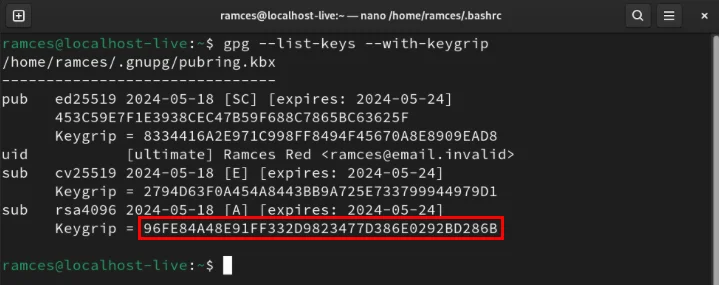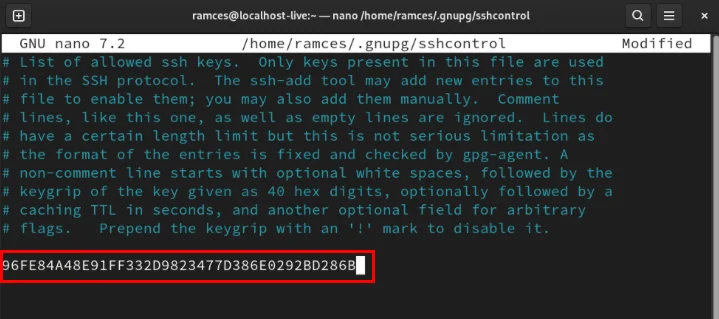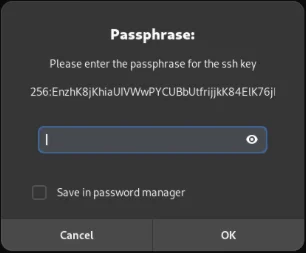How to log in to SSH server with GPG key
Prepare GPG key for SSH
The first step when using GPG keys on SSH is to create a new subkey. Doing this will allow SSH authentication details to be shared without affecting your main GPG identity.
Start by opening the GPG prompt for the master key:
gpg --expert --edit-key YOUR-KEY@EMAIL.ADDRESSNote : You can find the email address for your master key by listing the key's contents: gpg --list-keys .
Type 'addkey' on the GPG prompt, select '8' , then press Enter.

Set the subkey capability to '=A' then press Enter.

Enter '4096' in the key size prompt, then press Enter .
Set a reasonable time period for subkey validity. In this case, the example would be typing '1y' to make the new subkey only valid for one year.

Create a new GPG subkey by typing 'y' , then pressing Enter on the wizard's confirmation prompt.
Type 'quit' , then press Enter to exit the GPG prompt.
Confirm that the new subkey is working properly by getting details about the master key:
gpg --list-keys YOUR-KEY@EMAIL.ADDRESS 
Enable SSH support in GPG
Once the subkey is up and running, you can now configure your SSH daemon to accept incoming gpg-agent requests. To do that, add 'enable-ssh-support' to the current user's 'gpg-agent.conf' file:
echo "enable-ssh-support" >> ~/.gnupg/gpg-agent.confOpen the '.bashrc' file with your favorite text editor:
nano ~/.bashrcPaste the following lines of code at the end of the .bashrc file:
export SSH_AUTH_SOCK=$(gpgconf --list-dirs agent-ssh-socket)
gpgconf --launch gpg-agentSave the bashrc file, then print the subkey's keygrip:
gpg --list-keys --with-keygrip 
Copy the subkey's keygrip, then create the file 'sshcontrol' in the .gnupg directory :
nano ~/.gnupg/sshcontrolPaste your identity keygrip into the new file, then save it.

Apply the new SSH and GPG configuration by reloading the bashrc file on the current terminal session:
source ~/.bashrcCheck if the SSH daemon is currently working properly by listing its SSH public key:
ssh-add -l 
Export and check GPG key
At this point, you should have the SSH daemon correctly linked to your GPG agent. To use it, generate an SSH export key with the following command:
gpg --ssh-export-key YOUR-KEY@EMAIL.ADDRESS > ~/authorized_keysSet the export key's permission bits to be readable and writable only by the user:
chmod 600 ~/authorized_keysSend new authorization file to remote server using scp:
scp ~/authorized_keys YOUR-REMOTE.SERVER.DOMAIN:~/.ssh/authorized_keysLog in to the remote server, then restart the SSH daemon to apply the new key:
sudo systemctl restart ssh.servicePress Ctrl + D , then log back into the remote SSH server. This will bring up a new prompt asking to enter the master GPG key password.

Binding a GPG key to the SSH daemon and exporting it to a remote server are just some of the things you can do with SSH. Discover what can be done with this amazing software using SSH with UNIX pipes in Linux.
You should read it
- How to set up your own Git server on Linux
- Use IIS to set up FTP Server on Windows
- How to change DNS server on the most popular routers
- What is VPS? VPS used to do? What is VPS different from Server?
- 7 great ideas using Raspberry Pi as a server
- New points in SQL Server 2017
- Instructions for setting up and managing FTP Server on Windows 10
- Create VPN Server on Windows 8
May be interested
- What is the future of server virtualization?
 server virtualization can help combat poor server performance, make better use of computing capabilities, limit energy consumption and improve data center flexibility.
server virtualization can help combat poor server performance, make better use of computing capabilities, limit energy consumption and improve data center flexibility. - Learn about the architecture of MS SQL Server
 in the previous articles, you already know briefly about sql server, how to install sql server on the computer. in this section we will learn about the architecture of sql server.
in the previous articles, you already know briefly about sql server, how to install sql server on the computer. in this section we will learn about the architecture of sql server. - Instructions for installing MS SQL Server
 this is a step by step guide to installing ms sql server.
this is a step by step guide to installing ms sql server. - How to install DNS Server on Windows Server 2019
 from microsoft, the domain name system (dns) is one of the industry standard protocol sets that includes tcp / ip, along with dns client and dns server that provide name resolution services that map names to the ip addresses of computers. .
from microsoft, the domain name system (dns) is one of the industry standard protocol sets that includes tcp / ip, along with dns client and dns server that provide name resolution services that map names to the ip addresses of computers. . - Install Windows Server 2003 and create a backup server
 network management documentation server 2003 as details of how to install, create a companion server in case the main server is malfunctioning, create a domain, join the client to the domain, the conection {remote desktop from the client data to server}, set adsl router parameters to server, turn off 1 working machine immediately.
network management documentation server 2003 as details of how to install, create a companion server in case the main server is malfunctioning, create a domain, join the client to the domain, the conection {remote desktop from the client data to server}, set adsl router parameters to server, turn off 1 working machine immediately. - Instructions to change DNS Server on Windows, Mac, iOS and Android
 by default, your computer will automatically obtain dns information from your isp (isp). sometimes, dns servers are unstable and you are blocked from accessing certain websites. or the default dns server is blocked by some websites for a number of reasons. in this case you should change the dns server with the free public dns server.
by default, your computer will automatically obtain dns information from your isp (isp). sometimes, dns servers are unstable and you are blocked from accessing certain websites. or the default dns server is blocked by some websites for a number of reasons. in this case you should change the dns server with the free public dns server. - How to configure DNS Server on Ubuntu Server 11.04
 dns server is a server with domain name resolution function. in this article, we will detail the steps to install and configure dns server on linux with ubuntu server version 11.04.
dns server is a server with domain name resolution function. in this article, we will detail the steps to install and configure dns server on linux with ubuntu server version 11.04. - Instructions for setting up individual FTP Server with FileZilla
 unlike http - designed to forward hyper - text data over tcp connections, standard ftp ensures that the server responds to requests as soon as it receives a signal from the host. not only provides fast and accurate file transfer, but also security, gives users more options in the process of downloading and uploading data ...
unlike http - designed to forward hyper - text data over tcp connections, standard ftp ensures that the server responds to requests as soon as it receives a signal from the host. not only provides fast and accurate file transfer, but also security, gives users more options in the process of downloading and uploading data ... - HAVING clause in SQL Server
 the having clause is used in conjunction with the group by clause in sql server (transact-sql) to limit the group of returned rows, only when the condition is met is true.
the having clause is used in conjunction with the group by clause in sql server (transact-sql) to limit the group of returned rows, only when the condition is met is true. - What is a RADIUS Server? How does RADIUS Server work?
 radius server is a background process that runs on unix or windows servers. it allows you to maintain user profiles in the central database.
radius server is a background process that runs on unix or windows servers. it allows you to maintain user profiles in the central database.










 List of Samsung Galaxy devices that will not be updated to One UI 7 (Android 15)
List of Samsung Galaxy devices that will not be updated to One UI 7 (Android 15) 6 reasons you should choose Snapdragon X Elite chip for your next laptop
6 reasons you should choose Snapdragon X Elite chip for your next laptop Your data will probably never disappear
Your data will probably never disappear The plane had to make an emergency landing because of a laptop
The plane had to make an emergency landing because of a laptop 4 reasons to need a tripod to take photos on smartphones
4 reasons to need a tripod to take photos on smartphones Top 21 ADB commands Android users should know
Top 21 ADB commands Android users should know